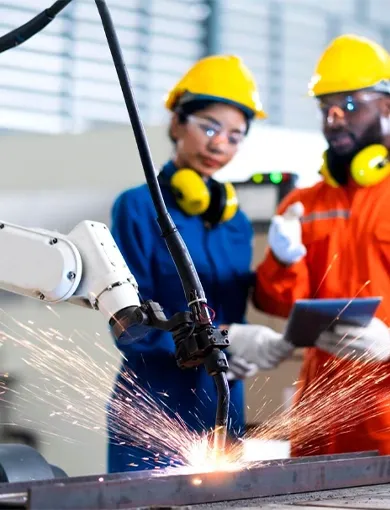Welding with Robots
Welding with robots is a technique used to enhance speed and precision in manufacturing stages. These systems ensure consistency in repetitive tasks and reduce error rates.
Welding with robots offers reliability in production through operations performed with high accuracy and without human intervention. In industrial use, it saves time, reduces costs, and significantly improves workplace safety. In this way, companies enhance quality and make operational efficiency sustainable.
Things to consider in automatic welding applications:
- Material compatibility should be checked: Appropriate types of metals must be selected for the robotic system.
- Programming accuracy must be ensured: The welding path and parameters should be precisely defined.
- Alignment controls must be carried out: There should be no gaps or misalignments between parts.
Regular maintenance must not be neglected: Periodic servicing is essential for the performance of robotic systems
What is Robotic Welding?
The rapid advancement of technology in the industry has elevated the role of automation in manufacturing stages. As a result of this transformation, welding operations have shifted from traditional methods to machine-integrated systems. Nowadays, robotic welding systems enable faster and more error-free production in many sectors.
Robots minimize welding errors by consistently executing the same processes. Especially in sectors like automotive and metal processing, welding robots boost productivity and support workplace safety. Thus, human-induced risks decrease, and the production process becomes more stable.
These systems, when integrated into the production line, reduce the workload of operators. This automation process, which requires less human intervention, also provides workers with development opportunities in other fields. Robot systems contribute not only to speed but also to quality control processes.

Advantages of robotic welding applications:
- Saves time by shortening production duration.
- Enhances quality by standardizing weld seams.
- Keeps operators away from hazardous environments.
- Offers long-term savings in maintenance and energy costs.
It is expected that welding with robots will become more widespread in production processes in the future. With the support of advanced artificial intelligence, these systems offer smarter and more adaptable solutions. Companies aim to increase quality while reducing costs. As a result, sustainability and efficiency in industrial production can be achieved simultaneously.
How is Welding Done with Robots?Nasıl Yapılır?
The robotic welding process ensures high efficiency through carefully planned technical steps and the right equipment selection. First, the geometry and position of the parts to be welded are modeled digitally. Then, this data is transferred to the robot’s control panel, and the operation path is defined. At this stage, the operator inputs welding type, speed, pressure, and temperature parameters into the robot system.
Once programming is complete, the robot is integrated into the production line and test runs are performed. The quality control of the test welds ensures system accuracy. If everything is in order, the robot is switched to automatic mode for mass production. From this point onward, the robot can repeat the defined welding process without human intervention.
The robot arm follows the predefined path and moves the welding torch at a steady speed and angle. During the application, sensors measure the real-time temperature and composition of the metal. This ensures a weld bead of high visual and structural quality. Additionally, laser measurement systems continuously monitor alignment.
Advanced robotic systems can detect vibration or surface flaws and automatically adjust their motion. This feature minimizes errors in production processes and ensures uninterrupted flow. This increases the reliability of welding operations and reduces the workload on the operator.
Welding applications are used in a wide range of industries, from automotive production lines to heavy industry. Robots are one of the most suitable solutions for tasks that require high speed, repeatability, and precision. Robotic welding offers a cost advantage and helps maintain quality standards.
The installation time depends on the system’s complexity and integration requirements. It typically ranges from a few weeks to several months and includes steps such as programming, testing, and operator training.
Although the initial investment is high, it becomes more economical in the long run due to labor savings, increased production speed, and improved quality. Additionally, minimizing errors and avoiding material waste reduce expenses.
Various methods such as MIG/MAG, TIG, spot welding, and laser welding can be integrated into robotic systems. The selection depends on production needs and material type.
Regular maintenance ensures the efficient and safe operation of the system. This includes software updates, inspections of mechanical components, and replacement of worn-out parts.
To benefit from robotic welding solutions in industrial production and to receive a customized offer, get in touch with Eko Kaynak today.

